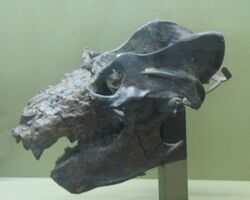Biology:Cynognathia
| Cynognathians | |
|---|---|

| |
| Skull of the carnivorous cynognathian Cynognathus crateronotus | |

| |
| Skull of Exaeretodon a herbivorous traversodontid | |
| Scientific classification | |
| Domain: | Eukaryota |
| Kingdom: | Animalia |
| Phylum: | Chordata |
| Clade: | Synapsida |
| Clade: | Therapsida |
| Clade: | Cynodontia |
| Clade: | Eucynodontia |
| Clade: | †Cynognathia Hopson and Barghusen, 1986 |
| Subgroups | |
| |
Cynognathia ("dog jaw") is one of two major clades of cynodonts, the other being Probainognathia. Cynognathians included the large carnivorous genus Cynognathus and the herbivorous or omnivorous gomphodonts such as traversodontids. Cynognathians can be identified by several synapomorphies including a very deep zygomatic arch that extends above the middle of the orbit.
Cynognathian fossils are currently known from Africa, Antarctica, Asia, Europe, North America and South America.
Taxonomy
- Suborder Cynodontia
- Infraorder Eucynodontia
- (unranked) Cynognathia
- Family Cynognathidae
- (unranked) Gomphodontia
- Family Diademodontidae
- (unranked) Neogomphodontia
- Family Trirachodontidae
- Subfamily Trirachodontinae
- Subfamily Sinognathinae
- Family Traversodontidae
- Etjoia
- Nanogomphodon
- Scalenodon
- Subfamily Traversodontinae
- Unnamed clade
- Andescynodon
- Pascualgnathus
- Mandagomphodon
- Subfamily Massetognathinae
- Subfamily Arctotraversodontinae
- Arctotraversodon
- Boreogomphodon
- Plinthogomphodon
- Habayia
- Maubeugia
- Microscalenodon
- Mandagomphodon
- Rosieria
- Subfamily Gomphodontosuchinae
- Family Trirachodontidae
- (unranked) Cynognathia
- Infraorder Eucynodontia
Phylogeny
Cynognathians in a cladogram after Stefanello et al. (2023):[2]
| Eucynodontia |
| |||||||||||||||||||||||||||||||||||||||||||||||||||||||||
See also
References
- ↑ Hendrickx, C.; Gaetano, L. C.; Choiniere, J. N.; Mocke, H.; Abdala, F. (2020). "A new traversodontid cynodont with a peculiar postcanine dentition from the Middle/Late Triassic of Namibia and dental evolution in basal gomphodonts". Journal of Systematic Palaeontology 18 (20): 1669–1706. doi:10.1080/14772019.2020.1804470. https://www.researchgate.net/publication/293802939.
- ↑ Stefanello, M.; Martinelli, A. G.; Müller, R. T.; Dias-da-Silva, S.; Kerber, L. (2023). "A complete skull of a stem mammal from the Late Triassic of Brazil illuminates the early evolution of prozostrodontian cynodonts". Journal of Mammalian Evolution 30 (2): 299–317. doi:10.1007/s10914-022-09648-y.
Wikidata ☰ Q5199968 entry
 |

